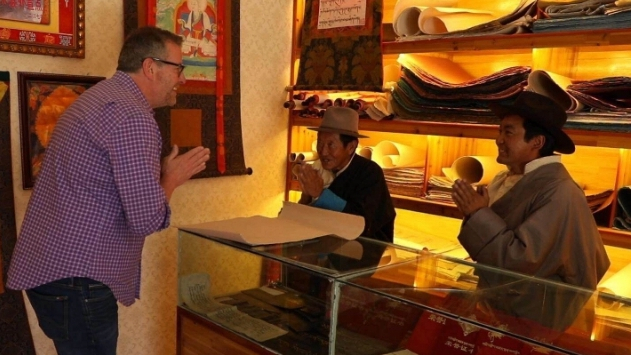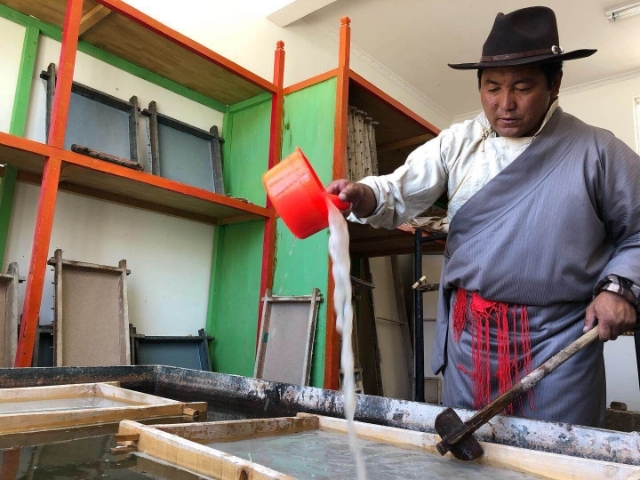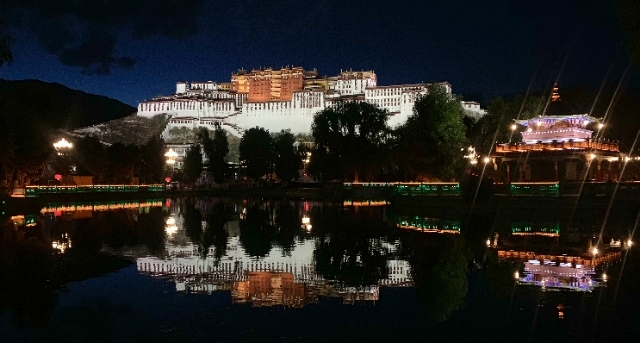

69-year-old Tsering Dorje, and his 39-year-old son Phurjung sit in their shop, and make products by practicing the traditional paper-making skills. /CGTN Photo
I knew it would be a series of stories to remember. Stories that would take your breath away in every conceivable way.
On June 16, I was just another guy sweating through a Washington, DC summer. Three days later, I am pushing the boundaries of 4,000 meters.
You really don't know how one will react to high altitude, until you are there.
So the day we landed, CGTN had oxygen at the ready, and a doctor just in case.
I am a guy who has been more concerned about my 401-k, than 14-k, but quickly gained respect for Tibet, and its well earned title of "Roof of the World."
We got to see Lhasa, the spectacular Potala Palace and Jokhang Temple, the spiritual center of Tibet.
Words don‘t do justice to the beauty, and important cultural and religious heritage of these entities and often, they are the first stop for tourists coming to Tibet.
Our stories are largely focusing on the Tibetan Plateau, an unspoiled beauty spot that pushes more than 3 miles above sea level, or roughly 5,000 meters.
We made a three-hour drive to Nyemo County where we met 69-year-old Tsering Dorje, and his 39-year-old son, Phurjung.

Phurjung ladles the watery paste made of wolfsbane into a handmade mold, before drying the paste into paper. /CGTN Photo
They are literally the last line of defense for preserving an important part of Tibet's culture.
They make paper the old-fashioned way, which has been done for 1,300 years.
They are the lone family in Tibet still practicing this craft.
The father tells me, they take the root from a grass called wolfsbane, a poisonous plant.
It's cut with water, then beaten into a clay like paste that is watered down to look like oatmeal, which you wouldn't eat because it is too thin. And then the watery paste is carefully ladled into handmade molds.
The thin layer dries in the sun in two hours and you will have a cloth-like piece of paper.
The family's work hangs in important temples in the area and is treasured for its durability and, well, just for the history.
Many of us bought small notebooks, and Dorje signed them and added a Tibetan prayer. He is a kindly man.
Seemingly there is always a smile creasing his sun-worn face. Interviewing him was another experience.
Sadly, I speak one language, and it is neither Tibetan nor Mandarin. So our trusty producer He Yu (who goes by the name Jade) became our problem solver in chief. I ask Jade the question in English, and she asks the question in Mandarin to a Tibetan who can speak it. The Tibetan then asks the question in Tibetan to Dorje .
This mini-UN conference goes on and on to the point where it takes about 30-minutes to ask four or five questions.

The night scene of the Potala Palace. /CGTN Photo
Leaving is always the hardest and a few hours aren't enough. But we have a full plate of work, and a long drive.
We don’t talk much about it, but we are all winded. Walking up to Potala Palace made me feel as though I had run a 10-k race.
Andrew Smith, our talented photographer broke one of the golden rules by sprinting 30-meters to convey some important information.
He paid the price.
Winded and tingling arms for the next 30 minutes or so.
But the drive makes you forget the headache, pain and other ills that come with high altitude.
Around each corner is a view more spectacular than the last, and of course the wonderful Tibetan people.
But that is another story. I will bring you that in a few days.

Copyright © 2018 CGTN. Beijing ICP prepared NO.16065310-3
Copyright © 2018 CGTN. Beijing ICP prepared NO.16065310-3